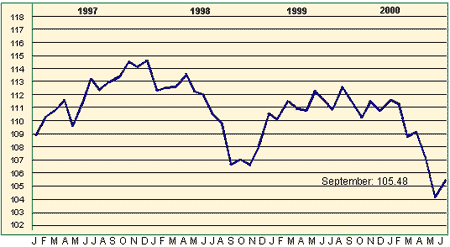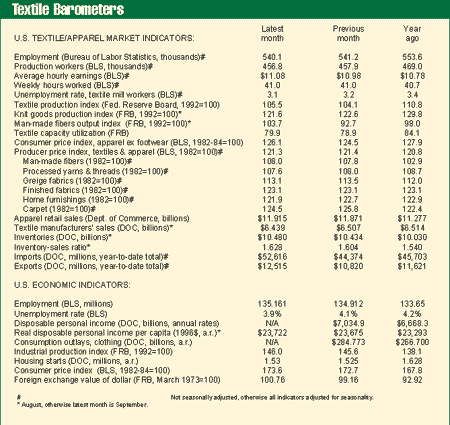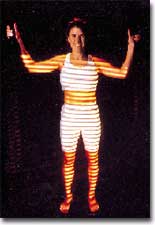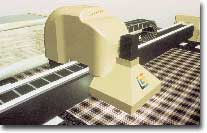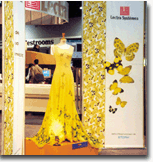Todd S. Lowenthal joined Atlanta-based
Air Quality Sciences Inc. as indoor air quality product manager.
The Astrup Co., Cleveland, has named
Peter Jagodzinski account representative for New York, Long Island and Westchester
County, while
Victor Cuesta, the new account representative in Miami, is responsible for
international markets.
EcomTextile.com, Fullerton, Calif., has appointed
Peter Ganga director, international sales and marketing.
Chicago-based
FMC Corp. appointed
Robert I. Harries head of the Industrial Chemicals Group, while
Daniel R. Summers was named general manager, Chemical Products businesses. The
reassignments are in conjunction with the announced year-end retirement of Corporate Vice President
Alfredo Bernad.
Atlanta-based
Wools of New Zealand has named
Hallie Cobb marketing manager, while
Ruth Hart,
Susan Hawkins and
Linda Keen have been appointed marketing executives for the company.
Servomex Group Ltd., Norwood, Mass., has appointed
Dr. Sam Langridge sales director with global responsibility for sales operations.
Saati Americas, Somers, N.Y., named
Tim McCue technical sales representative for the Mid-Atlantic region.
Aida Boone has joined the company as bilingual customer service specialist for
customers primarily in South Miami, Fla., and Central America.
Kay M. Villa, president, Kay M. Villa Consulting, Needham, Mass., was named
chairman, West Conshohocken, Pa.-based
American Society for Testing and Materials’ (ASTM) Committee D13 on Textiles. A
member of the ASTM Board of Directors, Villa is also a member of ASTM Committees E05 on Fire
Standards and F23 on Protective Clothing.
St. Louis-based
Dash Multi-Corp. appointed
William D. Sutton general counsel and secretary. Sutton brings more than 20 years
of business and legal experience to his new position.
National Textiles LLC, Winston-Salem, N.C., has promoted
Vernon Carson to vice president, manufacturing, while
David Shirlen has joined the company as vice president, human resources.
Ron Washburn was appointed vice president, sales and marketing; and
Byron Vines was promoted to director, yarn manufacturing. The company also named
Larry Gunn director, textile manufacturing.
Guilford Mills Inc., Greensboro, N.C., named
Kim Thompson vice president and CFO of the company.
John Collins has joined
Kapco (Kent Adhesive Products Co.), Kent, Ohio, as Midwest sales representative.
Collins will be based in Chicago.
Wise Industries Inc., Kings Mountain, N.C., has added
Mike Ruffalo to its technical sales group. He will share the domestic sales
responsibility for nonwoven equipment throughout the Southeast and West Coast.
Ben Watts and
Joe W. Faith have joined the sales team at
DyeTech Inc., Dalton, Ga.
Peter Oakley, chairman and CEO, BASF Corp., Mount Olive, N.J., has been named
chairman of the
Organization for International Investment, a Washington-based trade group that
represents U.S. subsidiaries of international companies.
Cotton Incorporated, Cary, N.C., has appointed
Sherry Ayazi manager, fashion marketing, apparel.
At the annual general meeting of the
European Disposables Nonwovens Assoc. (EDANA),
Krzysztof Malowaniec, Paul Hartmann AG, Germany, was elected chairman for a
one-year term of office.
Aldo Ghira, Tenotex SPA, Italy, was re-elected treasurer.
Ingemar Bengtson, Trioplanex International AB, Sweden, and
Hermann Eidel, Freudenberg Vliesstoffe, Germany, were both elected vice-chairman.
Tyrone L. Vigo, U.S. Department of Agriculture’s Southern Regional Research
Center, was presented the Olney Medal for achievement in textile chemistry at the 2000
International Conference and Exhibition of the
American Association of Textile Chemists and Colorists.
Roland L. Connelly, president and co-founder, SheLyn Inc., Greenboro, N.C., was
honored as the recipient of the Harold C. Chapin Award, while I
an D. Rattee and
W.E. Stephen were co-recipients of the Henry E. Millson Award for Invention.
Acme-Hardesty Co., Blue Bell, Pa., has named
Bryan A. Huston regional sales manager for metropolitan New York/New Jersey and
New England, while
Darin R. Barrow was ap-pointed regional sales manager for Texas, Oklahoma,
Louisiana and southern Mississippi.
D. Neil Fleming was named national sales manager.
William N. Gaughan was promoted to vice president, e-business and information
technology,
Bayer Corp., Polymers and Chemicals Division, Pittsburgh.
November 2000

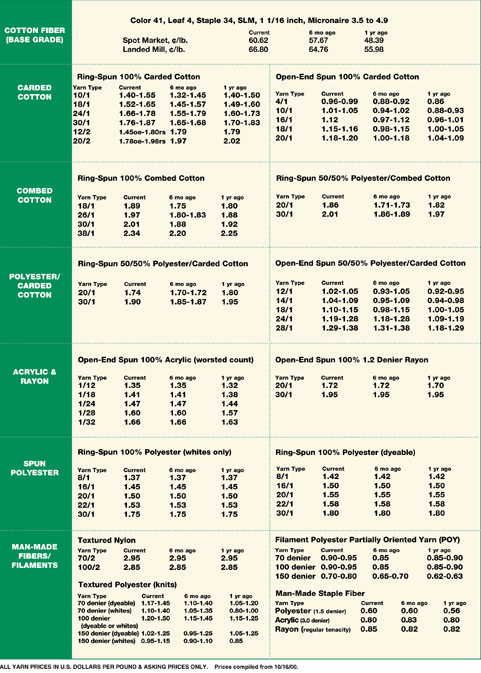
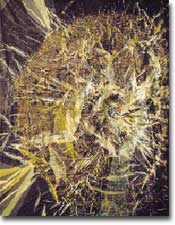 J
J